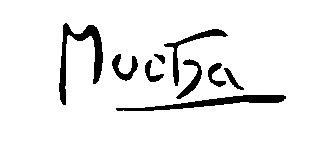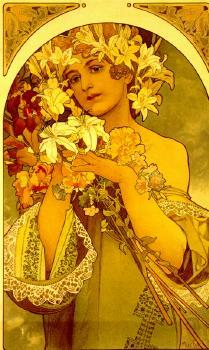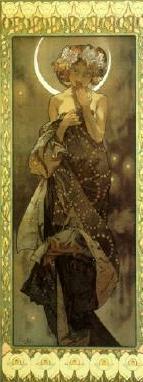Alphonse Mucha

|
Alphonse Mucha is most remembered for his contributions to the French Art Nouveau movement at the turn of the century. Art nouveau is remembered as a decorative art movement. It started in Western Europe and lasted for about forty years, from the 1880s to World War I. Characterized by a richly ornamental, asymmetrical style of whiplash linearity, and reminiscent of twining plant tendrils, art nouveau was found in furniture, jewelry, posters, particularly movie posters, book design and illustration. Its themes were symbolic. 
Autumn Alphonse Mucha was born Moravia in what is now the Czech Republic in 1860. He childhood drawings showed great talent at a very early age. He showed an early interest in a career as a history painter and painted traditional religious and historical subjects. For some time, Mucha had sponsors; however, when these were lost, he found it necessary to paint minor commissions and had to illustrate books, magazines, and calendars. In 1894, a rush order came in from Sarah Bernhardt for a picture to promote her role in the play "Gismonda". Mucha was the only artist available. The picture by Mucha was not conventional, but Miss Bernhardt loved it. Mucha gained immediate fame. Because his style was so revolutionary, his art became widely known in Europe as "le style Mucha." 
Moon After the initial picture, Mucha was commissioned to do more work for Miss Bernhardt. His work for her included costumes, stage decorations, announcements, jewelry, and many pictures. Mucha is known for his feminine curves and flowing lines combining the natural world with women. The masses loved his works because of the form, exquisite detail, fluid movement of design, and balance. He created numerous posters, pictures, calendars, and illustrations. Mucha contributed greaatly to art. His new style was inspirational, elegant, collectible, and popular. The Mucha Museum in Prague is filled with his beautiful paintings, a must to see if one visits Prague. |
Other famous people & artists
Mucha posters at Art.com
Back